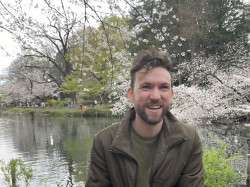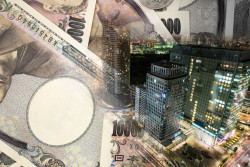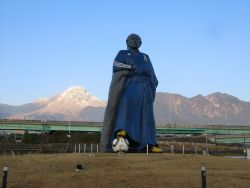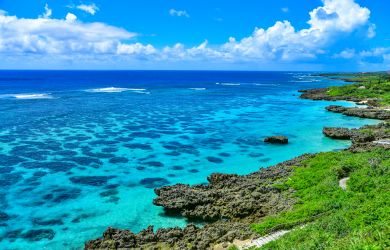
September 26, 2011
Islands of Kagoshima
A string of emeralds dividing the Pacific from the East China Sea
By Metropolis
Originally published on metropolis.co.jp on September 2011


It’s before dawn and I’m groping through a dark forest. As I climb the cedar mountainside, the rain intensifies to a deluge. Here on Yakushima, clouds bring five meters of water annually. Soon my digital camera is swimming in an inch of rain, and never takes another photo. So much for my waterproof bag.
The forest is a universe of deep zinc moss, silver rivulets and black roots webbing great glistening rocks, all shot through with icy torrents from above. It seems more an Avatar digital backdrop than an island two hours’ sail from Kagoshima. But Yakushima’s yaku sugi trees are no computer mirage.
Found above 1,200 meters, the giant cedars are like mighty rivers of rock. Some are 20 meters tall and eight meters around, but I reached the granddaddy of them all, Jomon Sugi, and could only gape. It towered over the camphor trees, 16 meters in circumference and 25 meters high. Its age is anywhere from 2,000 to 5,000 years, but everyone agrees it’s the largest and oldest specimen of Cryptomeria japonica. If you want to be awed by nature, put this one on your list.

Yakushima was the second stop on a quick ferry circuit I did from Kagoshima. My first took me past its puffing volcano Sakurajima to Tanegashima, a long, narrow island where 16th-century shipwrecked Portuguese introduced firearms to Japan. In the sleepy port of Nishi no omote, I found the Teppokan museum. Dressed up like a Portuguese galleon, it features early Japanese guns based on European matchlocks. The summertime Teppo Matsuri is a massive firearms show and parade where matchlocks are shown off and fired. This technology altered the course of Japanese history, and Tanegashima remains on the bleeding edge. In its southeast corner, past some pristine beaches and bungalow inns catering to surfers, is the Tanegashima Space Center, where JAXA rockets blast off into the stratosphere. I arrived in my rental just in time for a tour that included enormous decommissioned rocket stages and viewing the launch pads from afar.
Most Yakushima and Tanegashima ferries don’t go farther south. In Kagoshima, I bought a one-way ¥14,200 Maruei/A Line ticket that would bring me all the way to Naha in Okinawa. It lets you alight at four islands over a one-week period before you reach Okinawa. If you don’t mind bedding down on a communal floor in second class, it’s a sweet deal.

I first disembarked at the port of Naze on Amami-Oshima, 350km south of Kyushu. It felt like I’d crossed into balmier latitudes: Amami is a nature-lover’s paradise of mangrove forests, coral reefs and postcard beaches. The subtropical, squiggly-coasted island had suffered rain-induced landslides and several roads were impassable. But that didn’t stop my innkeeper, a middle-aged woman with a deep tan, from insisting on driving me up the coast, past the Kinsakubaru virgin forest—home to species such as the Amami thrush, habu pit viper, and Amami black rabbit—to Sakibaru beach, one of the island’s finest. Nearby Crater Bay has superb diving opportunities, tropical fish and sea turtles, as well as inns catering to divers.
I was blessed with similar hospitality on Tokunoshima. My innkeeper, a pot-bellied man with a peppery buzz cut, chauffeured me around, pointing out a neighborhood with many centenarians (was there something in the water?), and pausing at cowsheds along the road. This is where cattle are bred for the ancient sport of togyu, or bovine sumo. Handlers goad bulls into locking horns to push the other out of a ring, just like human sumo; there’s even a yokozuna top bull. If there are no tournaments on, Tokunoshima’s wild coastal rock formations are a worthy distraction—one, Innojofuta, is a giant coral structure that looks like a pair of glasses.
Windswept Okinoerabujima was next down the line. Covered with sugarcane (kurozato black sugar is the local snack), it’s flat, sparsely populated and seemed to have more goats than people. After hiking the jagged north cliffs alongside a wandering herd, I toured the Shoryudo caves, 600 meters of spectacular illuminated limestone caverns near the center of the island. I found two other unusual sights: Japan’s largest banyan tree, set in a schoolyard full of kids who were agog at a tall foreigner; and a monument to the Lizze C. Troop, a Canadian ship that ran aground in 1890—locals were also amazed at the survivors, and cared for them until they could journey home.
Kagoshima’s final inhabited island is one of its smallest but, for me, the most charming. Yoronjima (aka Yoron-to) is only five kilometers across and shaped somewhat like an angelfish, ringed by white-sand beaches and topped with gentle hills. I was soon navigating its sugarcane by scooter, and stopping for a swim at Oganeku Kaigan, a popular windsurfing spot. Yoron’s best asset, though, is the warmth of its people. Most have fled the metropolises of Honshu to settle in the island’s laidback embrace, and now run relaxing establishments like Bar Natural Reef and Umi Café, both in the village of Chabana. Atop a concrete tower known as the Southern Cross Center, the northernmost point in Japan where that constellation can be seen, I spied Cape Hedo in Okinawa, some 20km to the south.
The next day I was in Naha, but already planning my return to Kagoshima’s jeweled tail.
trip tips
- Japan Airlines flies to Kagoshima, Yakushima, Tanegashima, Amami-Oshima, Tokunoshima, Okinoerabujima, and Yoronjima. Check prices at www.jal.com
- Skymark Airlines flies to Kagoshmia and Amami-Oshima. www.skymark.jp
- ANA also flies to Kagoshima. www.ana.co.jp
- Kagoshima Shosen/Toppy (www.toppy.jp) runs ferries from Kagoshima to Tanegashima (¥12,600 return) and Yakushima (¥14,000 return); it also sails between the islands (¥3,700 one-way)
- Maruei Ferry/A Line sails from Kagoshima to Naha, stopping at Amami-Oshima, Tokunoshima, Okinoerabujima, and Yoron. A combined 2nd-class ticket is ¥14,200.







